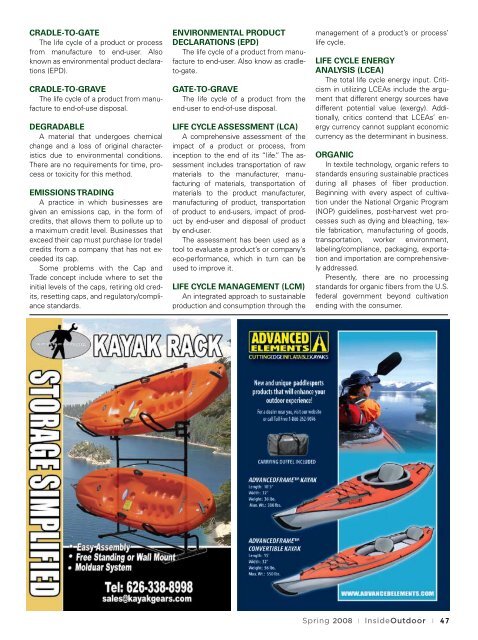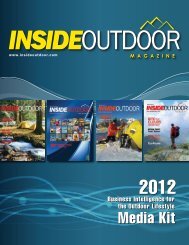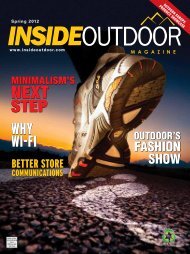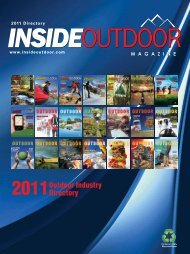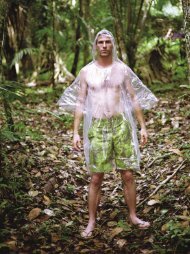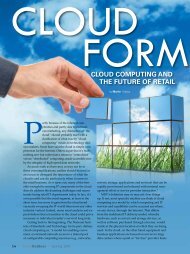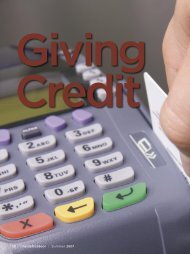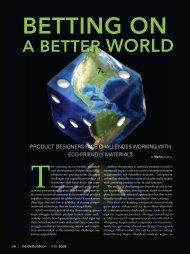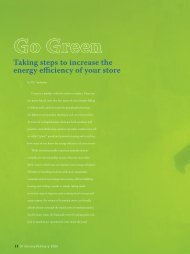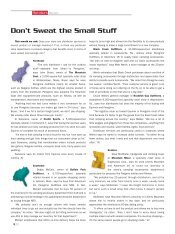Spring - InsideOutdoor Magazine
Spring - InsideOutdoor Magazine
Spring - InsideOutdoor Magazine
You also want an ePaper? Increase the reach of your titles
YUMPU automatically turns print PDFs into web optimized ePapers that Google loves.
Cradle-to-gate<br />
The life cycle of a product or process<br />
from manufacture to end-user. Also<br />
known as environmental product declarations<br />
(EPD).<br />
Cradle-to-grave<br />
The life cycle of a product from manufacture<br />
to end-of-use disposal.<br />
Degradable<br />
A material that undergoes chemical<br />
change and a loss of original characteristics<br />
due to environmental conditions.<br />
There are no requirements for time, process<br />
or toxicity for this method.<br />
Emissions Trading<br />
A practice in which businesses are<br />
given an emissions cap, in the form of<br />
credits, that allows them to pollute up to<br />
a maximum credit level. Businesses that<br />
exceed their cap must purchase (or trade)<br />
credits from a company that has not exceeded<br />
its cap.<br />
Some problems with the Cap and<br />
Trade concept include where to set the<br />
initial levels of the caps, retiring old credits,<br />
resetting caps, and regulatory/compliance<br />
standards.<br />
Environmental Product<br />
Declarations (EPD)<br />
The life cycle of a product from manufacture<br />
to end-user. Also know as cradleto-gate.<br />
Gate-to-grave<br />
The life cycle of a product from the<br />
end-user to end-of-use disposal.<br />
Life cycle assessment (LCA)<br />
A comprehensive assessment of the<br />
impact of a product or process, from<br />
inception to the end of its “life.” The assessment<br />
includes transportation of raw<br />
materials to the manufacturer, manufacturing<br />
of materials, transportation of<br />
materials to the product manufacturer,<br />
manufacturing of product, transportation<br />
of product to end-users, impact of product<br />
by end-user and disposal of product<br />
by end-user.<br />
The assessment has been used as a<br />
tool to evaluate a product’s or company’s<br />
eco-performance, which in turn can be<br />
used to improve it.<br />
Life Cycle Management (LCM)<br />
An integrated approach to sustainable<br />
production and consumption through the<br />
management of a product’s or process’<br />
life cycle.<br />
Life Cycle Energy<br />
Analysis (LCEA)<br />
The total life cycle energy input. Criticism<br />
in utilizing LCEAs include the argument<br />
that different energy sources have<br />
different potential value (exergy). Additionally,<br />
critics contend that LCEAs’ energy<br />
currency cannot supplant economic<br />
currency as the determinant in business.<br />
Organic<br />
In textile technology, organic refers to<br />
standards ensuring sustainable practices<br />
during all phases of fiber production.<br />
Beginning with every aspect of cultivation<br />
under the National Organic Program<br />
(NOP) guidelines, post-harvest wet processes<br />
such as dying and bleaching, textile<br />
fabrication, manufacturing of goods,<br />
transportation, worker environment,<br />
labeling/compliance, packaging, exportation<br />
and importation are comprehensively<br />
addressed.<br />
Presently, there are no processing<br />
standards for organic fibers from the U.S.<br />
federal government beyond cultivation<br />
ending with the consumer.<br />
<strong>Spring</strong> 2008 | <strong>InsideOutdoor</strong> | 47


